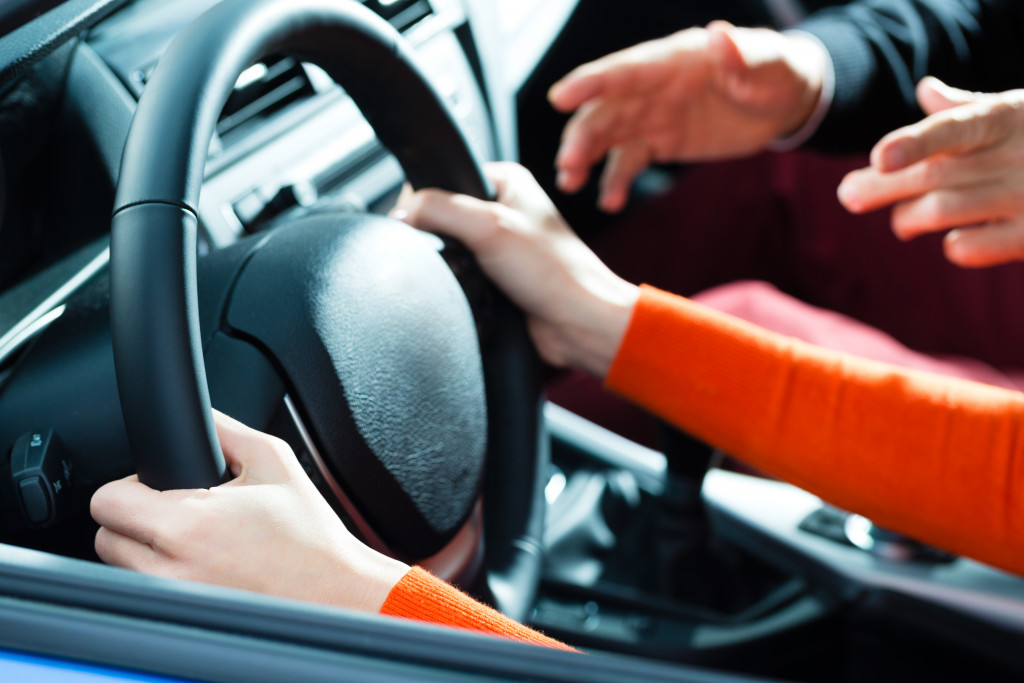No discussion – following traffic laws, rules, and regulations is the best way to ensure driving safety. This goes without saying when it comes to driving a vehicle, but the same safety issues apply when bike driving. However, people sometimes violate the rules and expose their own and other people’s safety at risk.
You can find yourself in complex and risky situations caused by extreme weather conditions, vehicle performance capabilities, or dense traffic. Each situation demands different skills and reactions. In this article, we’ll take a look at the best tips for safe driving and how to avoid risky situations in the first place!
Start with Learning
Everything starts with proper knowledge. Seeking help from a family member may not be enough to become a responsible driver. It’s important to obtain the proper education and training. Here are ways to get the training and information needed to become a responsible driver:
Enrolling in Driving School
Enrolling in a trusted driving school is the best way to learn road rules and improve your skills. Most states require a certain number of hours of instruction to obtain a learner’s permit or driver’s license. This kind of foundation helps create a good understanding of the basics.
Reading Driver’s Education Material
Learning about driving does not only have to be done in person. Many books, magazines, and other materials are filled with useful information on driving responsibly. You can also find helpful videos online demonstrating certain techniques or offering advice on certain topics.
Practice in Different Conditions
Before hitting the roads alone, practice driving in various weather and traffic conditions. These conditions include rain, snow, highway driving, city streets, and more. It’s important to get comfortable and confident in different environments so that you can react quickly, no matter the situation. This will help you become more prepared for when you encounter these same conditions on the roads.
Follow Traffic Laws and Rules of The Road
Being a responsible driver means following the rules of the road and traffic laws. These laws are not only important to keep you safe, but they are also in place to protect other drivers. Here are ways to start:
Use Turn Signals

Always use your turn signals whenever you make a lane change or turn. Your turn signals warn other drivers of your intentions, so using them is important. Not using them could cause an accident or inconvenience to other drivers.
Obey Speed Limits
Speed limits are in place for a reason, and they must be followed. Pay attention to the posted speed limit signs and do not exceed them. This is key to avoiding tickets and accidents. These are usually located in areas with a high concentration of pedestrians or other vehicles. Stay alert and keep your speed low.
Be Wary of Distractions
Distractions such as talking on the phone or having an unruly passenger can lead to major accidents. Not being able to keep your eyes and hands off your phone or other items increases the chances of getting into an accident. When driving, it’s important to stay focused and alert at all times.
Drive Defensively
In addition to following traffic laws, it is also important to practice defensive driving techniques on the roads. This means always staying focused on the task at hand—driving—while remaining aware of potential hazards around you, such as aggressive drivers or distracted pedestrians. You should also be sure to maintain an appropriate distance between yourself and other vehicles on the road; this will give you more time to react if something unexpected occurs. Here are some tips for practicing defensive driving:
- Keep your speed reasonable to ensure you have more time to react.
- Scan the road ahead and behind you often to look for potential hazards.
- Be aware of vehicle blind spots, both yours and others.
- Avoid tailgating or cutting off other drivers.
Stay Sober

Drunk driving accounts for about 10,000 deaths in the United States every year. It is an incredibly dangerous and irresponsible practice that puts the driver at risk and endangers everyone else on the roads. According to a study, more than 230 children were killed in drunk-driving crashes in the US in 2019 alone. This is why it is important to never drive under the influence of drugs or alcohol. Here are essential tips to abide by when it comes to drinking and driving:
- Always have a designated driver if you plan on drinking.
- Call a taxi or any TNVS if you don’t have someone to take you home.
- Stay the night where you are rather than risk an accident.
Learning to be a responsible driver takes time, practice, and dedication. If you focus on these basic tips, however, you can be sure that your driving will always be safe and efficient. It also helps to remember that everyone makes mistakes; just try your best to learn from them. Remember, safety always comes first when you are on the road.
Rules and Regulations: A Common Ground for Safe Driving
Pedestrian and driver safety is the top priority in the established traffic legislation and rules. For example, drinking and driving are prohibited in any state or country. In countries like France or England, there’re laws on the allowed BAC (blood alcohol concentration) while driving a vehicle. Every other country has them, including the US.
The obvious reason for this is the horrifying statistics showing that, in the USA, about 30 people die daily due to driving under the influence of alcohol. That’s why various states in the USA have laws on allowed driving BAC(blood alcohol concentration) – it’s usually between 0.15% and 0.8%.
There’re many other examples, such as driving speed restrictions. For instance, in England, the allowed speed limit while driving in urban areas is 30 mph, while on dual carriageways and motorways, the maximum speed is 70 mph. On the other hand, in the USA, the speed limit ranges between 65 and 80 mph for rural interstate highways or 55 mph on all other highways.
Various states also have laws on using mobile phones or other devices. They’re for preventing distracted driving or engaging in multiple activities while driving. The best safe driving tip for this is to put all devices away and avoid multitasking.
Violations of these and other common sense rules can result in penalties and driving restrictions because you’re putting your and other peoples’ lives at stake. That’s why following the active traffic rules and legislation is the foremost of the safety driving tips.
List of Top 25 Driving Tips for Riders
There are hundreds of safe driving tips you can master to ensure the safety of your and the other active participants in everyday traffic. Following are some of the essential tips on how to become a responsible driver instantly after the motor turns on:
- Avoid distracted driving – Put all electrical devices away and avoid multitasking at all costs.
- Avoid alcohol intake – Alcohol can seriously impact your behavior and slow down your reactions.
- Avoid sedatives – Especially benzodiazepines which increase the possibility of crashes.
- Respect the traffic lights
- Get enough sleep and rest – No sleep and tiredness can impair your reactions.
- Don’t overload the vehicle
- Maintain your vehicle
- Don’t drive over the speed limit
- Always use the blinkers
- Keep a buffer – Don’t stay too close to other traffic participants.
- Stay out of other driver’s blind spots – Make yourself visible to drivers and predictable.
- Keep an eye on your own blind spots – Predict and avoid being surprised!
- Wear your seat belt
- Avoid assumptions – Follow the signals and respect rights.
- Drive attentively – Anticipate the possible scenarios or situations and read the signals.
- Make weather adjustments
- Prepare for longer journeys – Have a co-driver for periodical changes behind the wheel.
- Respect the right of way
- Respect emergency vehicles
- Get your eyesight checked – Eyesight loss is also an impairment.
- Use GPS devices if necessary
- Wait till everyone puts a seatbelt on – seat belts increase the survival chances by 80%.
- Always check fuel beforehand
- Get all documents in place – Driver’s license, ID card, and other valid documents.
- Get new documentation if necessary
Incredible Tips for Bike Drivers
There are also some safety driving tips that bike drivers should be aware of. Bike drivers can be extremely vulnerable and are exposed to high risk because of potential accidents of inattentive car driving. Following are some of the best driving tips for bikers and motorcyclists.
Safety Driving Tips for Bicycle Riders
Here are five terrific tips to ensure safe and responsible bike driving. Some of them refer to specific situations, while others are more general.
- Obey every traffic rule – this is very important because bikers are an easy target for the more heavy and faster vehicles.
- Always look before turning – Anticipate the following situation, and be attentive and ready to yield.
- Wear a helmet – Whenever you can or when you cycle on longer distances and highways.
- Follow the forecast – Weather conditions can seriously impair your driving skills.
- Adjust your bicycle – Maintaining the body, tires, and brakes is essential.
Safety Driving Tips for Motorcyclists
The driver safety tips for motor riders don’t differ a lot from those for bicycle riders. However, there are differences because of the increased speed and driving area. Following are some of the best careful driving tips for motorcyclists:
- Wear your safety gear – Helmets and other gear increase the survival chances in a motorbike crash.
- Use hand signals – Sometimes, it is necessary to use hand signals, especially if you’re in a car driver’s blind spot.
- Always be visible – stay away from blind spots.
- Participate in a safety course – On these courses, learn how to react in different situations and how to manipulate the vehicle most effectively.
- Keep distance – always keep a safe distance between the previous vehicle or motorcycle.
Tips For Driving Car Safely
In addition to our previous driving tips, there’re many tips for careful driving and ensuring driver’s safety. Some of the more crucial tips for driving cars safely are adjusting the mirrors and the driving speed and preparing for weather and seasonal conditions.
- Adjust your mirrors – Properly adjusted mirrors allow you to check your blind spots and prevent accidents.
- Adjust your speed – It’s sometimes necessary to drive even below the allowed speed limit because of the weather conditions or increased traffic.
- Share the road – Respect the unconditional right of way of pedestrians and emergency vehicles.
Tips and Safe Driving Practices In Specific Situations
Numerous situations demand increased concentration, focus, and other preventive measures. The most frequent ones are the increased traffic and extreme weather conditions. For instance, the road could be icy, or the traffic could be stuck on some of the city’s main streets. The best driving tips for such risky situations are maintaining your vehicle and practicing defensive driving.
Car or bike maintenance is essential for meeting the optional safety criteria of the vehicle, like the proper working of the brakes, tire quality, proper in-car electronics alignment, and more. Maintenance significantly reduces the risks associated with crushes or road accidents and their possibility. A driving tip for effectively maintaining your vehicle is regular inspections, maintenance, and servicing.
Defensive Driving
Defensive driving can save lives in multiple situations, especially during dense traffic or extreme weather conditions. Defensive driving is a conscious deducement of the dangers associated with driving.
An example would be keeping a reasonable distance between your and the other vehicles and following the 3-4 second rule. Other defensive driving safety tips can be frequent checks of your mirrors and scanning the surroundings.
The main benefit of defensive driving is the reduction of collision risk. Other benefits are increased vehicle longevity, decreased fuel consumption, improved driving skills, no violation charges, etc.
- Check all your blind spots and always use signals
- Wearing driving gloves and gear (especially for motorcyclists)
- Adjust mirrors and use wipers
- Always have access to your first aid and winter gear
Final Words
There’re many driving tips that you can follow to ensure safe and secure driving. However, the most essential and effective ones are the tips and prohibitions included in the traffic laws and regulations of the specific country.
The driver’s top priority should be respecting the numerous traffic rules and procedures and preparing the vehicle for specific traffic conditions. Moreover, each driver should exercise defensive and avoid distracted driving to guarantee the pedestrians’ and drivers’ safety.
FAQs
1) How can I get better at driving?
The best driving tips for becoming a better driver are obeying the traffic rules, staying alert, removing distractions, and respecting driving as a meaningful activity.
2) What are the common mistakes to avoid while driving?
The most common mistakes are breaching the speed limit, not following the traffic rules, not checking the blind spots, and forgetting to use blinkers.
3) What is the hardest thing to learn in driving?
The hardest part of driving is to keep in your lane and to practice driving patiently.
4) How long does it take to get a driving license?
On average, in the United States, you’ll need between two and eight months to get your brand-new driving license.
5) Where should I undergo a driving test to obtain the license?
You should apply at some of the licensed and reliable driving schools and undergo training before you undergo a driving test in a less urbanized area with fewer lanes.





